Eggs have been one of the most readily available foods since time immemorial. They have been loved for their rich flavor and high protein content.
Egg lovers have different methods of presenting their egg dishes. How do you like yours? Do you like them fried, boiled, poached, scrambled, or as an omelet? It can be hard to choose, but guess what? The way you cook an egg isn’t the only option: there are many more eggs than the regular chicken eggs to choose from.
Depending on the type, you can experience a wide range of egg flavors, larger yolks, shorter cooking times, and better dish presentation. However, some eggs might be very rare and others very expensive, but they are all worth a try.
I have prepared a list of edible eggs in this article and, most importantly, what you should avoid. Let’s have a look.
Table of Contents
What are Eggs?
Eggs are the reproductive vessels produced by birds, fish, reptiles, and insects for their procreation. Most bird eggs are considered food, but you should know that not all eggs are edible.
Most eggs have three main parts; the outermost shell, the protective layer, the albumen or white, and the yolk in the core. Eggs are generally rich in proteins and vitamins, but the yolk has the highest nutrient concentration.

Why Do Eggs Have Different Colors?
As you might have noticed, eggs do not often have uniform colors. Others might have darker spots on the surface or assume other colors like blue, green, brown, and more.
Needless to say, the color of an egg doesn’t determine edibleness or nutritional content. The egg’s coloration depends on the genes of the bird laying the egg. Plymouth Rock hens, for example, lay brown eggs, while others like Americana hens lay blue eggs.
Interestingly, all eggs start white, only assuming their coloring and random pigmentation in the oviduct or the bird’s uterine tube as they are laid.
Are All Eggs Edible?
No, not all eggs are edible. Although most eggs produced by birds, fishes, and reptiles are generally safe for consumption, some should be avoided.
Generally, if a creature is poisonous to eat, then its eggs are also most definitely poisonous.
For example, hooded Pitohui and Blue-capped Ifrit birds native to Papua New Guinea produce eggs with traces of batrachotoxin, a lethal toxin that the birds get from eating a local poisonous beetle.
Reptile eggs are also fast gaining popularity, but you should definitely avoid snake eggs. Luckily, these are not the kind of eggs you will stumble upon daily.
11 Types of Edible Eggs
1. Chicken Eggs
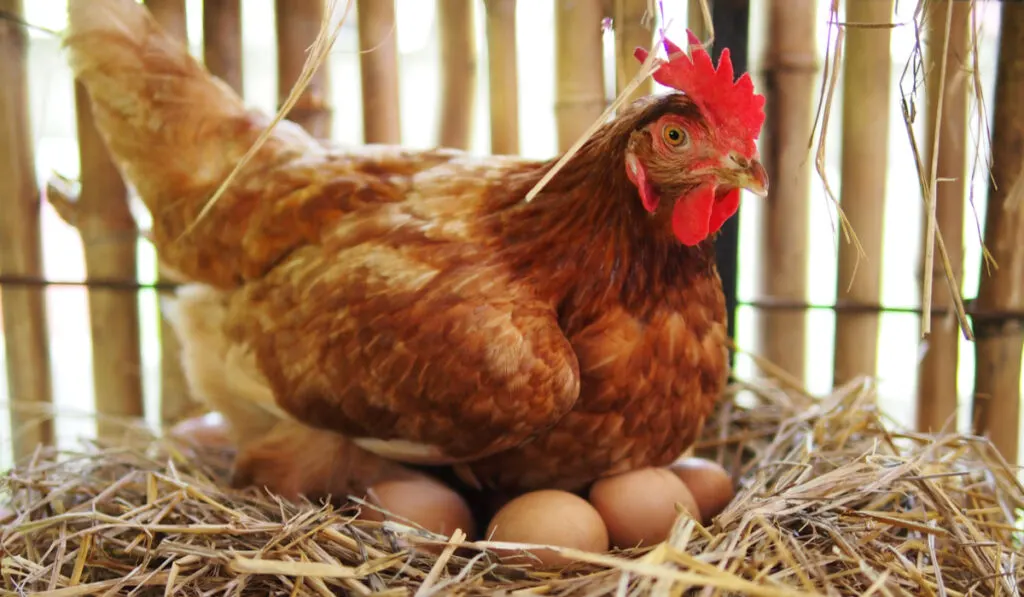
Chicken eggs are the most abundant eggs in any market, and everybody knows about them. Depending on the breed laying the egg, colors can range from white to brown, blue, chocolate, and olive green, but the nutritional value is the same.
Chicken eggs are generally rich in proteins, vitamins A and D, calcium, zinc, and about 63 calories per medium-sized egg. They also have a mild taste but are even tastier if they are free-range or fresh from the farm.
Chicken eggs have many culinary uses and are used in most cuisines. For example, in Asia, you’ll find eggs in dry egg soup, and Oyako Don (chicken and egg over rice) dishes, while much of the western world breaks their fast with egg dishes or sandwiches.
2. Duck Eggs

Compared to chicken eggs, duck eggs are larger, often weighing an average of 2.5 ounces (70 grams). Duck eggs are white to pale yellow. The shells are also thicker, meaning that they can stay fresh longer.
Duck eggs have creamy, yellow yolks that turn orange when boiled and have a luxurious taste that is richer and smoother than chicken eggs. However, the eggs of ducks that often spend time in the water might have a slightly fishy smell. But the eggs of homegrown ducks have no such smell.
Duck eggs are also nutrient-rich and have higher nutrient levels compared to chicken eggs, boasting 130 calories for an average egg, as well as proteins, vitamins A and B12, selenium, calcium, iron, and potassium.
Duck eggs also have a significant amount of fat and cholesterol, but this doesn’t change the demand for them in restaurants. Some famous duck-egg dishes include duck egg flan, duck egg salad with smoked salmon or bacon and asparagus, and duck eggs baked with quinoa.
3. Turkey Eggs
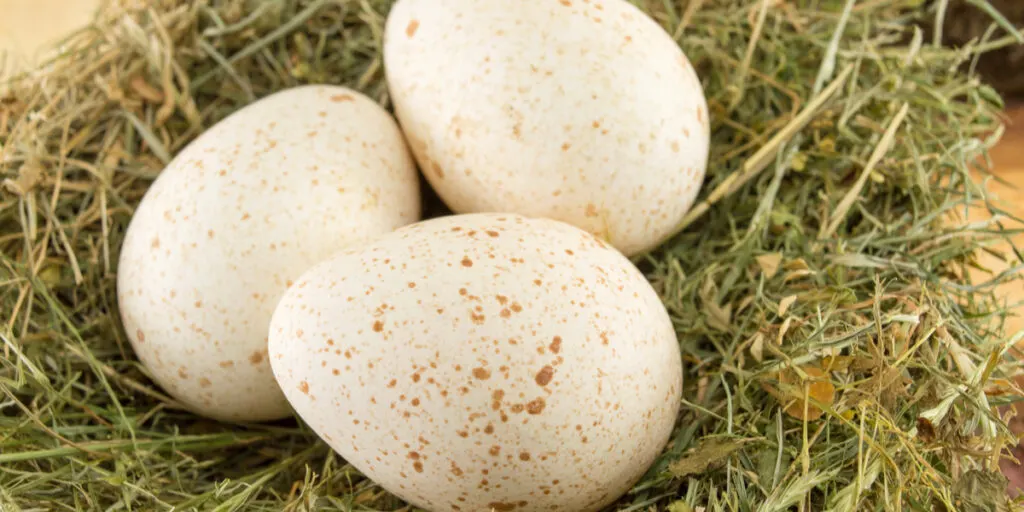
Even though they are edible, turkey eggs don’t have much commercial demand. Turkey eggs are slightly larger with thicker, brown-speckled shells and weigh an average of 2.3 – 3.5 ounces (66 – 100 grams) depending on the turkey breed.
A turkey only produces an average of 100 eggs per year, meaning that the eggs are quite rare, so they are costly.
Thanks to their larger yolks and viscous whites, turkey eggs have a smoother taste and texture. However, turkey eggs have arguably the same flavor and nutrient profile as chicken eggs. An average turkey egg provides 135 calories and contains proteins, vitamins, and fats.
Turkey eggs are best consumed when fried, but some people prefer them for cooking pastries because of their intense flavor. However, turkey eggs are quite rare, as most farmers prefer incubating the eggs and breeding the birds than selling the eggs.
4. Ostrich Eggs

Ostrich eggs are the largest eggs on our list, weighing an average of 2.6 to 4 pounds (1.2 to 2 kg). Each egg is about an average of 24 chicken eggs in size.
Ostrich eggs have creamy white shells that are extremely hard and 20 times thicker than chicken eggshells. Hard boiling an ostrich egg would take 1.5-2 hours.
Except for their gamey taste, ostrich eggs have a flavor profile similar to chicken eggs. On the other hand, an average ostrich egg contains 2,000 calories, half a pound of protein, and 3.5 ounces of fat, as well as iron, calcium, and many more minerals.
Owing to its size and the fact that it is not readily available, an ostrich egg is often expensive. Some common ostrich egg dishes include ostrich egg omelets; bacon, cheese, potato, and ostrich egg frittata; and ostrich egg fatty redux.
5. Quail Eggs
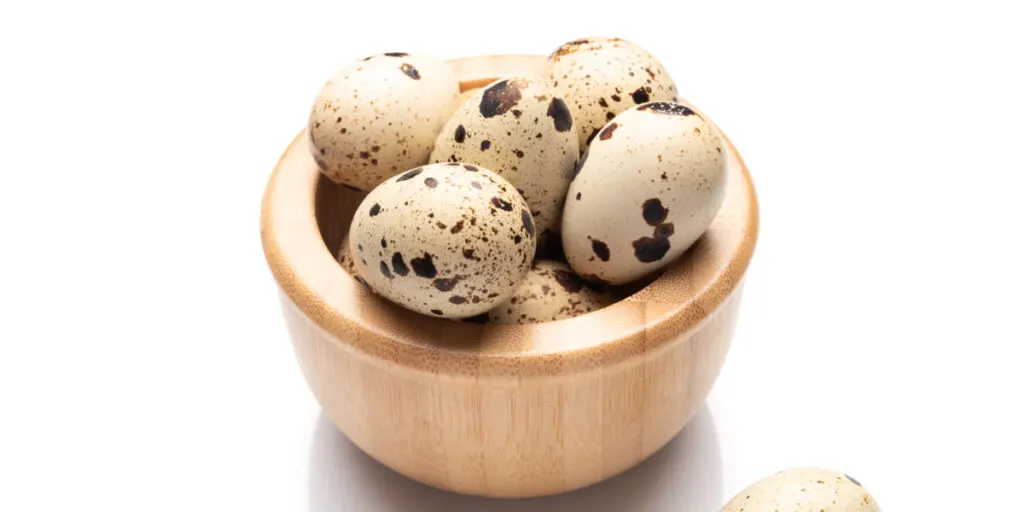
Quail eggs are tiny, often weighing an average of 0.3 ounces (9 grams). This is much lighter than the 1.2 ounces (50 grams) of chicken eggs.
Quail eggs might be tiny, but they are very tasty. You just need up to six quail eggs to make a decent meal. Quail eggs are cream in color, often with black or brown speckles randomly scattered on the shell.
Since the egg is so small, it only offers 14 calories but is also packed with many nutrients, including protein, selenium, and vitamins B12, D, and riboflavin.
Quail eggs are highly sought after and are considered a delicacy in many cuisines, especially in Asian dishes. However, thanks to their size, they are hard to peel and are therefore best consumed hard-boiled or deviled.
Some of the most common quail egg recipes include quail scotch eggs, quail egg soup, and piperrada and quail eggs.
6. Pheasant Eggs
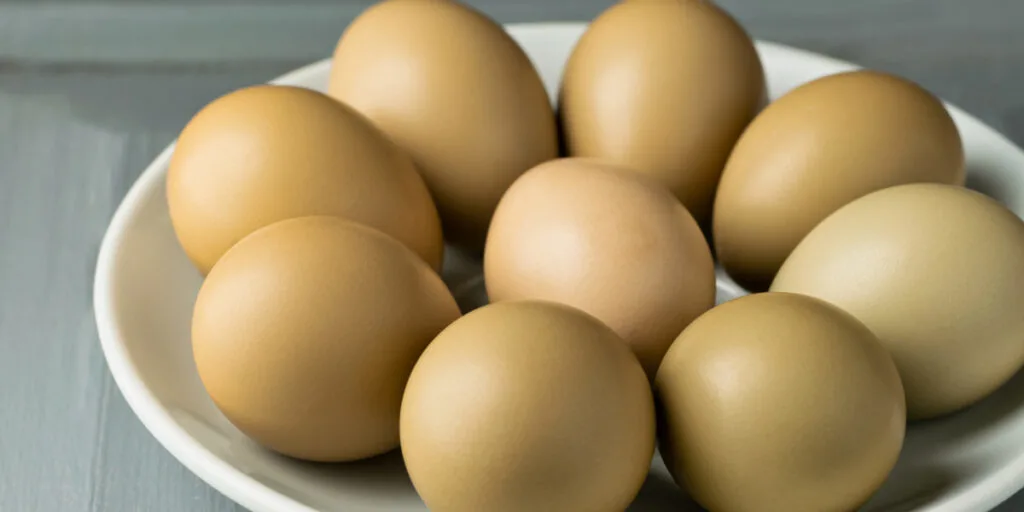
Pheasants produce eggs half the size of chicken eggs, often with brown to pale olive-green shells. Their eggs also have dark yellow yolks that comprise more of the egg volume and do not taste much different from chicken eggs, except that they are richer and creamier.
Pheasant eggs work well with any egg dish, whether scrambled, boiled, fried, or poached. An average pheasant egg offers 135 calories, not to mention other nutrients like proteins, vitamins A and B12, zinc, and selenium.
7. Rhea Eggs

Rheas are big, flightless birds physically similar to ostriches. A rhea lays an average of 20 to 60 eggs per year in a laying season ranging from May to August. Each egg weighs an average of 1.3 pounds.
Rhea eggshells often range from light greenish to flat off-white and are equivalent to 10 chicken eggs nutrition-wise. They also have a potent and robust flavor despite their yolk having a lighter composition.
8. Pigeon Eggs

People have eaten pigeon eggs since time immemorial, and these eggs are even considered a prized delicacy in most Asian cultures, along with quail eggs.
Pigeon eggs are smaller than chicken eggs but are larger than quail eggs, although the egg size greatly depends on the breed of the pigeon. Larger breeds will often produce larger eggs. Also, the egg white for pigeon eggs is slightly denser and clearer than chicken eggs.
Like most eggs, pigeon eggs are nutrient-rich and are in high demand for Asian and French dishes. The most common recipes using pigeon eggs include Buddha jumps over the wall, wood pigeon salad with soft poached eggs, and pigeon egg noodle soup.
9. Gull Eggs

Gull eggs are uncommon but very delicious and are a sought-after delicacy in many parts of the U.K. However, they are only available on the U.K. coastline for a very short time in early spring when the birds make their nests and lay eggs.
Gull eggshells are often cream-colored with random brown spots and will vary in size depending on the breed of the gull that lays it.
Nutrient-wise, an average gull egg offers about 139 calories and is packed with other essential proteins and minerals. They are cooked in many ways, scrambled, hard-boiled, and fried, etc.
10. Emu Eggs

Emu eggs are fairly large, with their shells assuming a dark bluish color with lighter speckles. They are beautiful to see by themselves.
Emu eggs measure an average of 1 – 1.5 pounds (450 – 650 grams) and offer a whopping 360 calories besides a host of nutrients, including proteins, vitamins, omega acids, and other minerals.
11. Caviar
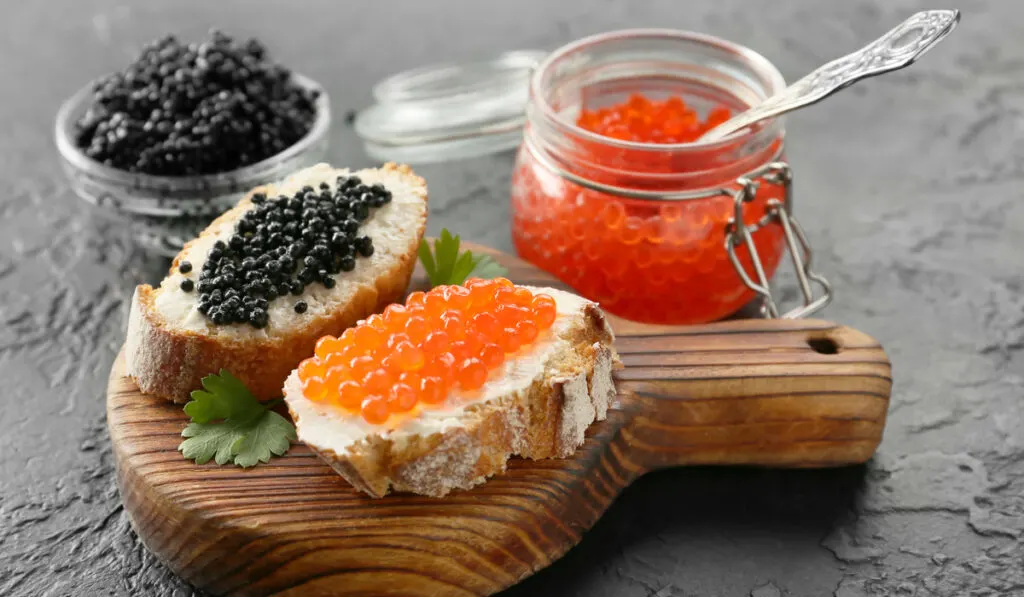
Unlike bird eggs, caviar is prepared from sturgeon fish eggs. Their colors and textures often vary depending on the fish breed laying it.
Caviar has a nutty, briny taste which gets stronger when the eggs pop in your mouth. Caviar is a favorite for garnish on bread and salads.
Nutrition-wise, 264 calories are found in every 3.4 ounces (100 grams) of caviar. Caviar also contains minerals and nutrients like magnesium and cobalamin.
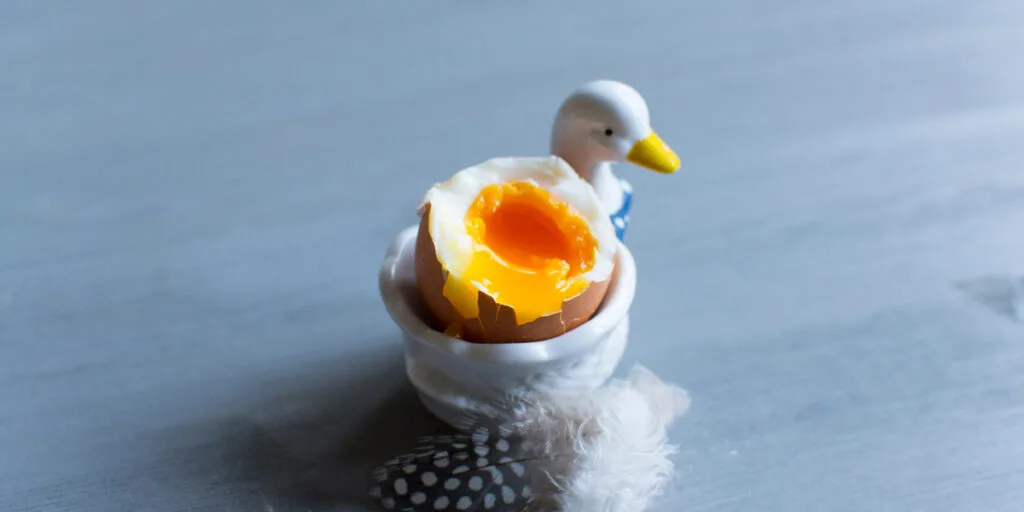
Other Edible Eggs
The list above is not an exhaustive list of all the edible eggs available today. However, there exist a couple more bird, reptile, and even insect eggs that are edible. Among other birds’ eggs are bantam chicken eggs, guinea fowl eggs, and goose eggs.
On the other hand, most reptile eggs are known to be safe for consumption, except for a few exceptions like snake eggs. Turtle eggs and crocodile eggs are the most commonly consumed reptile eggs and are even known to be more delicious with a richer flavor compared to bird eggs.
For example, in the Philippines, a restaurant even sells crocodile ice cream, which is a weird thing, right? Guess what? The product sells like candy.
For insect eggs, there isn’t much information on their edibility. Therefore, using our rule-of-thumb criteria, poisonous creatures will often have poisonous eggs. However, this might not be the case with some insects because some of the poisonous ant species are treated as delicacies in most parts of Southeast Asia and Mexico. But we don’t recommend testing that out!
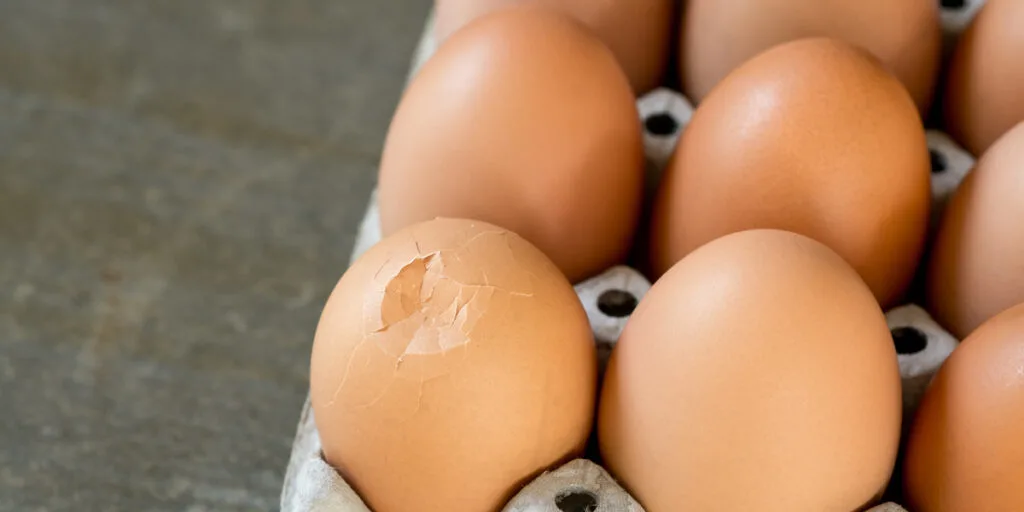
Eggs You Should Not Eat
Now that you know the edible eggs from the inedible eggs, what should you look out for with edible eggs?
- Eggs with cracks on the shell are not fit for consumption if they are stored for extended periods because bacteria can get in and contaminate the egg through the cracks.
- Eggs with a noticeable eggy odor signify a heavy infestation of bacteria, which can lead to food poisoning if consumed.
- Hard-boiled eggs with hard-to-peel shells accompanied by an odor are also an indication of stale eggs.
- An egg with a broken yolk when cracked also indicates the possibility of a bacterial invasion through the eggshell that begins the breakdown of the yolk’s protein structure.
- Half-boiled or raw eggs should also be avoided because the bacteria in the egg might not have been completely eliminated during the boiling process.
Conclusion
Eggs are among the most consumed food products in the world today. But, you can diversify your egg consumption with different egg varieties. I hope the article above helped guide you through alternative egg options for your dishes.
Resources:
- https://247wallst.com/special-report/2018/10/03/10-kinds-of-edible-eggs-that-dont-come-from-chickens/3/
- https://food.ndtv.com/food-drinks/10-different-types-of-edible-eggs-1784859
- https://timesofindia.indiatimes.com/life-style/food-news/6-types-of-eggs-that-you-can-eat/photostory
- https://www.dailymail.co.uk/femail/food/article-3038106/11-eggs-eating-instead-hen-s-eggs.html
- https://stylesatlife.com/articles/different-types-of-eggs-to-eat/
- https://www.homestratosphere.com/type-of-eggs/
- https://goodyfeed.com/6-types-of-eggs-that-you-should-not-eat/
- https://survivalfreedom.com/are-all-eggs-edible-4-animal-types-examined/
